5Aunit3第三课时教案
- 格式:doc
- 大小:71.00 KB
- 文档页数:4
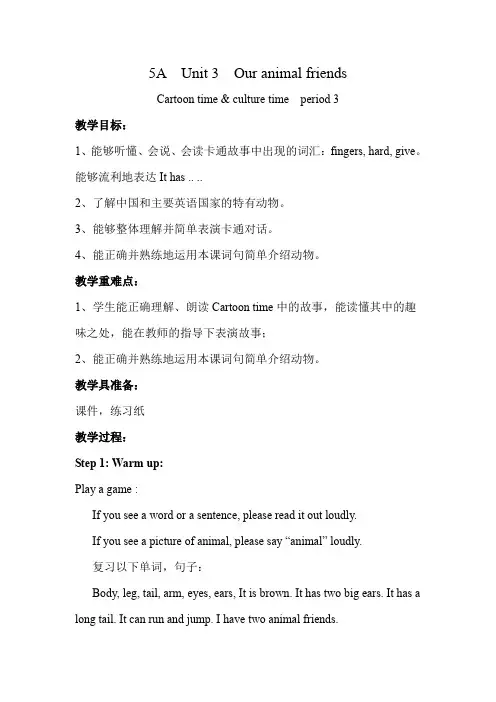
5A Unit 3 Our animal friendsCartoon time & culture time period 3教学目标:1、能够听懂、会说、会读卡通故事中出现的词汇:fingers, hard, give。
能够流利地表达It has .. ..2、了解中国和主要英语国家的特有动物。
3、能够整体理解并简单表演卡通对话。
4、能正确并熟练地运用本课词句简单介绍动物。
教学重难点:1、学生能正确理解、朗读Cartoon time中的故事,能读懂其中的趣味之处,能在教师的指导下表演故事;2、能正确并熟练地运用本课词句简单介绍动物。
教学具准备:课件,练习纸教学过程:Step 1: Warm up:Play a game :If you see a word or a sentence, please read it out loudly.If you see a picture of animal, please say “animal” loudly.复习以下单词,句子:Body, leg, tail, arm, eyes, ears, It is brown. It has two big ears. It has a long tail. It can run and jump. I have two animal friends.Step 2: Cartoon time1、接上述游戏。
T: I have two friends, too.One is yellow. Can you guess ‘What is it?’课件出示:What is it?It has big ears.It has big eyes.It has two arms.It has two legs.It has a long tail.It can run and jump.待学生猜测过后,课件依次出示Sam的各个部分,最终呈现谜底Sam。
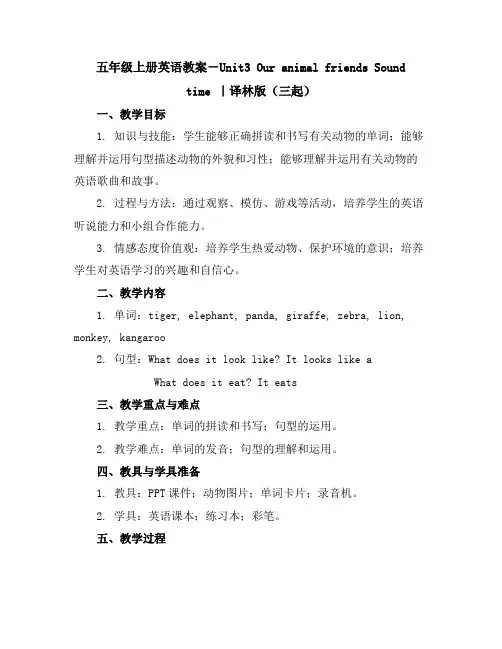
五年级上册英语教案-Unit3 Our animal friends Soundtime |译林版(三起)一、教学目标1. 知识与技能:学生能够正确拼读和书写有关动物的单词;能够理解并运用句型描述动物的外貌和习性;能够理解并运用有关动物的英语歌曲和故事。
2. 过程与方法:通过观察、模仿、游戏等活动,培养学生的英语听说能力和小组合作能力。
3. 情感态度价值观:培养学生热爱动物、保护环境的意识;培养学生对英语学习的兴趣和自信心。
二、教学内容1. 单词:tiger, elephant, panda, giraffe, zebra, lion, monkey, kangaroo2. 句型:What does it look like? It looks like aWhat does it eat? It eats三、教学重点与难点1. 教学重点:单词的拼读和书写;句型的运用。
2. 教学难点:单词的发音;句型的理解和运用。
四、教具与学具准备1. 教具:PPT课件;动物图片;单词卡片;录音机。
2. 学具:英语课本;练习本;彩笔。
五、教学过程1. 导入:播放英语歌曲《Old MacDonald Had a Farm》,引导学生复习有关动物的单词。
2. 新课呈现:利用PPT展示动物图片,引导学生学习新单词和句型。
3. 活动设计:小组合作,用英语描述自己喜欢的动物;角色扮演,模拟动物的生活场景。
4. 巩固练习:完成练习册上的相关练习;听录音,跟读单词和句型。
六、板书设计1. 单词:tiger, elephant, panda, giraffe, zebra, lion, monkey, kangaroo2. 句型:What does it look like? It looks like aWhat does it eat? It eats七、作业设计1.抄写本节课所学的单词和句型。
2.用英语描述自己喜欢的动物,不少于5句话。
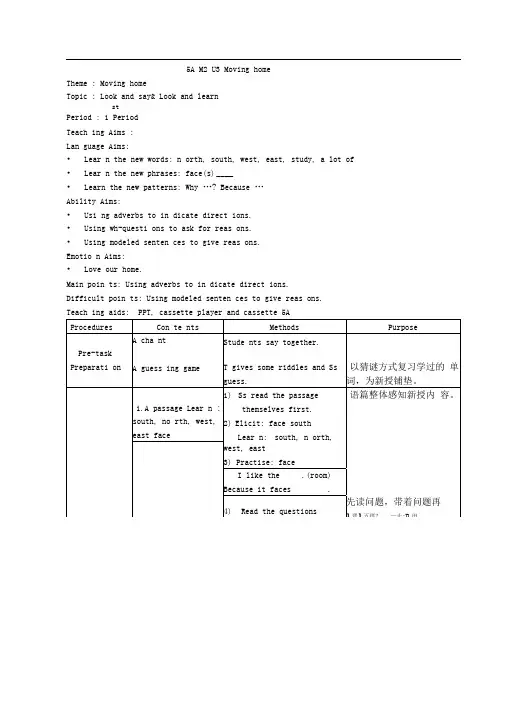
5A M2 U3 Moving homeTheme : Moving homeTopic : Look and say& Look and learnstPeriod : 1 PeriodTeach ing Aims :Lan guage Aims:•Lear n the new words: n orth, south, west, east, study, a lot of •Lear n the new phrases: face(s) ____•Learn the new patterns: Why …? Because …Ability Aims:•Usi ng adverbs to in dicate direct ions.•Using wh-questi ons to ask for reas ons.•Using modeled senten ces to give reas ons.Emotio n Aims:•Love our home.Main poin ts: Using adverbs to in dicate direct ions.Difficult poin ts: Using modeled senten ces to give reas ons.Teach ing aids: PPT, cassette player and cassette 5ATheme : Moving homeTopic : Peter 'new homePeriod : 2nd PeriodTeach ing Aims :Lan guage Aims:•Lear n the new words: share, through, take•Lear n the new patter ns: It takes ___ by bus.Ability Aims:•Using wh-questi ons to ask for reas ons.•Using modeled senten ces to give reas ons.Emotio n Aims:•Love our home.Mai n poi nts:•Using wh-questi ons to ask for reas ons.•Using modeled senten ces to give reas ons.Difficult poi nts: Ss can talk about their homes and give reas ons to the room they like.Teach ing aids: PPT, cassette player and cassette 5AThe second paragraphThethir dparagraphSay and act 1.Ss read the sec ondparagraph.2.Elicit: through3.Show the differe neebetwee n cross andthrough.4.Practise:We must ___________ theroad very carefully.We walked _____________the forest.You can' t _________ theroad when the light is redI try to get into the room________ the wi ndowbecause I can ' t open thedoor.1.Ss read the thirdparagraph.2.E licit: take, take 20minu tes by bus3.Practise:My home is far away fromschool. It takes_____ .(乘公交车需要1小时)The cinema is near myhome. It only takes______ .(步行需要5分钟)1.Ss watch the flashabout the dialogue.2.Ask and an swer.How many bedrooms are therein Peter ' s n home?Does Peter like his room?Why?Who shares the学习第二段语段,了解cross 与through的区别,通过练习巩固知识点。
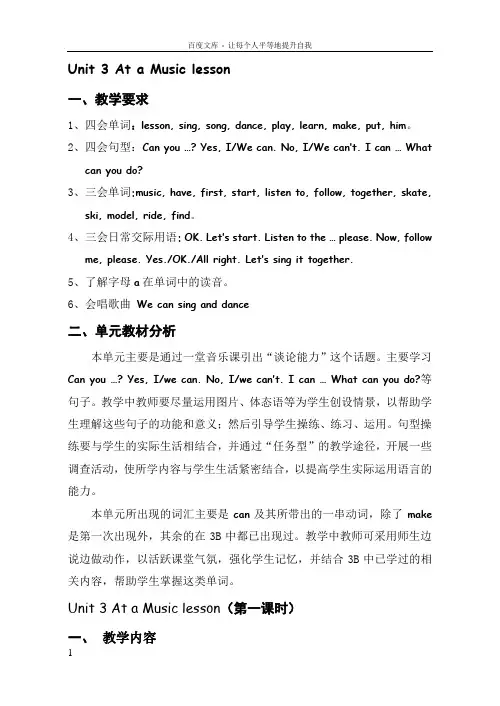
Unit 3 At a Music lesson一、教学要求1、四会单词:lesson, sing, song, dance, play, learn, make, put, him。
2、四会句型:Can you …? Yes, I/We can. No, I/We can’t. I can … Whatcan you do?3、三会单词:music, have, first, start, listen to, follow, together, skate,ski, model, ride, find。
4、三会日常交际用语: OK. Let’s start. Listen to the … please. Now, followme, please. Yes./OK./All right. Let’s sing it together.5、了解字母a在单词中的读音。
6、会唱歌曲We can sing and dance二、单元教材分析本单元主要是通过一堂音乐课引出“谈论能力”这个话题。
主要学习Can you …? Yes, I/we can. No, I/we can’t. I can … What can you do?等句子。
教学中教师要尽量运用图片、体态语等为学生创设情景,以帮助学生理解这些句子的功能和意义;然后引导学生操练、练习、运用。
句型操练要与学生的实际生活相结合,并通过“任务型”的教学途径,开展一些调查活动,使所学内容与学生生活紧密结合,以提高学生实际运用语言的能力。
本单元所出现的词汇主要是can及其所带出的一串动词,除了make 是第一次出现外,其余的在3B中都已出现过。
教学中教师可采用师生边说边做动作,以活跃课堂气氛,强化学生记忆,并结合3B中已学过的相关内容,帮助学生掌握这类单词。
Unit 3 At a Music lesson(第一课时)一、教学内容B Look, read and learnC Look and say二、教学目标1、能听、说、读、写单词dance, play, make。
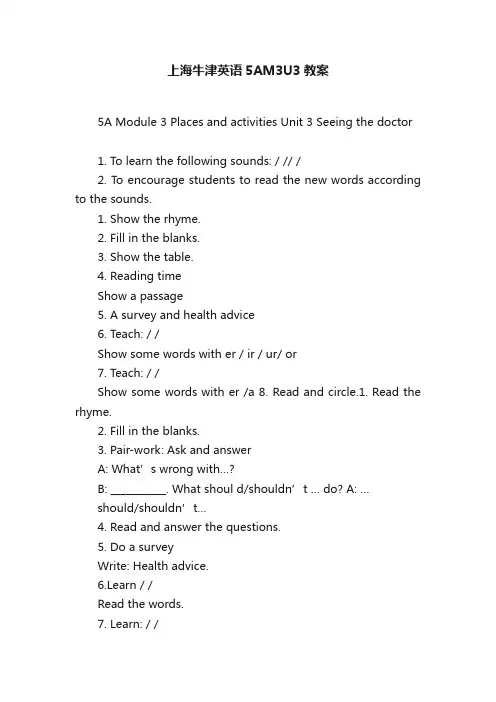
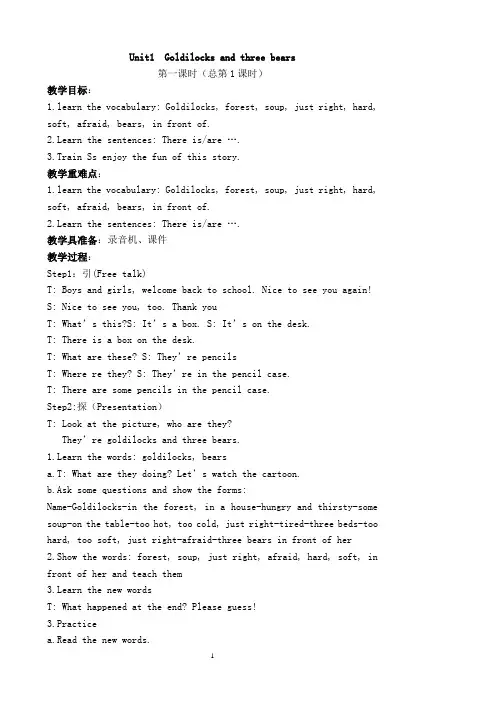
Unit1 Goldilocks and three bears第一课时(总第1课时)教学目标:1.learn the vocabulary: Goldilocks, forest, soup, just right, hard, soft, afraid, bears, in front of.2.Learn the sentences: There is/are ….3.Train Ss enjoy the fun of this story.教学重难点:1.learn the vocabulary: Goldilocks, forest, soup, just right, hard, soft, afraid, bears, in front of.2.Learn the sentences: There is/are ….教学具准备:录音机、课件教学过程:Step1:引(Free talk)T: Boys and girls, welcome back to school. Nice to see you again! S: Nice to see you, too. Thank youT: What’s this?S: It’s a box. S: It’s on the desk.T: There is a box on the desk.T: What are these? S: They’re pencilsT: Where re they? S: They’re in the pencil case.T: There are some pencils in the pencil case.Step2:探(Presentation)T: Look at the picture, who are they?They’re goldilocks and three bears.1.Learn the words: goldilocks, bearsa.T: What are they doing? Let’s watch the cartoon.b.Ask some questions and show the forms:Name-Goldilocks-in the forest, in a house-hungry and thirsty-some soup-on the table-too hot, too cold, just right-tired-three beds-too hard, too soft, just right-afraid-three bears in front of her2.Show the words: forest, soup, just right, afraid, hard, soft, in front of her and teach them3.Learn the new wordsT: What happened at the end? Please guess!3.Practicea.Read the new words.b.Listen to the tape and notice the pronunciations and intonationsc.Listen to the tape and noticed.Read after the tape.e.Try to read the text.Step3:测1.Read the text together.2.Choose one kind of reading and act it.Step4:迁Describe the classroom: There is/are … on/in/ ….Step5:Homework1. Copy the new words and sentences.2. Read, recite and act this story.板书设计:练习设计:教学后记:第二课时(总第2课时)教学目标:1. learn the vocabulary: beside, between.2. Learn the grammar of sentences: There is/are ….3.Train Ss can use the sentences: There is/are … correctly4. Review the words about feelings教学重难点:1. learn the vocabulary: beside, between.2. Learn the grammar of sentences: There is/are ….3.Train Ss can use the sentences: There is/are … correctly教学具准备:录音机、课件教学过程:Step1:引(Warming-up)1.T: At first, let’s read the story together.T: Read this story in roles.T: Act this dialogue, please.2.Talk about the learning tip.Step2:探(Presentation)1.T: What’s this? S: It’s a bag.T: Where is it? You may say “It’s between the desks.”(Teach: between)Learn the vocabulary.2.T: What are these?S: They’re apples.T: Where are they? You may say “They’re beside the bag. Teach: beside Learn the vocabulary3.Read the new words.4.Look at these pictures.a.Talk about these pictures and repeat this storyCheck the answers.(b, c, f, d, a, e)b.Look and talk about the pictures.Try to say them: There’s a house in the forest. There’s some soup in the table. There are three beds in the room. There are three bears in front of me.c.Check and write these sentences.d.Say the rules about it.5.Read and act the story6.Check and write these sentences.Step3:测(Consolidation)Describe my bedroom: There is/are … on/in/ ….Step4:迁1.Copy the new sentences.2.Describe my bedroom by oneself..板书设计:练习设计:教学后记:第三课时(总第3课时)教学目标:1.Learn the word: tool, doctor, says, put on, cannot, find, their, really.2.Learn the sentences: There aren’t any …. Here are …. XX can ….3.Learn the phonetic of the letter “c”.4.Enjoy this cartoon story.教学重难点:1.Learn the words: tool, doctor, say, put on, cannot, find, their, really.2.Learn the sentences: There aren’t any …. Here are …. XX can ….3.Learn the phonetic of the letter “c”.教学具准备:录音机、课件教学过程:Step1:引(Warming-up)1.T: Let’s describe our classrooms or our schoolbags, OK?2.Write some sentences.3.Read and recite the new words.4.Write some sentences about places.Step2:探(Presentation)1.T: Look at the picture, please.2.Listen to the tape.3.Teach the new words: tool, doctor, says, put onFind the same letter “c”.Read the phonetic /k/.4.Read the short text.5.Find the other words.6.Act the short text.Read the short text.7.T: Look at the picture, who are they?(Watch the cartoon.)T: What are they saying? Let’s watch the cartoon, please.S: They’re Bobby and Tina.8.Ask and answer, then fill in the forms.a.Teach the new words: cannot, find, their, really,Bobby-hungry-some cakes-in the kitchen, in the fridgeb.Teach the new sentences: There aren’t…any …. Here are ….c.T: Read the new words and sentences, please.9.Listen to the tape and read after it, then notice the pronunciations and intonations.10.Act the dialogue.Step3:测(Consolidation)Make some sentences: There isn’t/aren’t …. Here is/are ….Step4:迁1.Copy the new sentences.2.Read, recite and act this cartoon story.板书设计:练习设计:教学后记:第四课时(总第4课时)教学目标:1.Review the vocabulary and patterns of this unit.2.Learn the different drinks culture in western countries and China.3.Learn how to describe the places correctly.4.Appraise the harvest about this unit.教学重难点:1.Review the vocabulary and patterns of this unit.2.Learn the different drinks culture in western countries and China.3.Learn how to describe the places correctly.教学过程:Step1:引(Warming-up)1.Greetings and free talk.2.Read, recite and act this cartoon story.3.Do some exercises about the phonetic /k/4.Enjoy and act the cartoon story.Step2:探(Presentation)1.T: What’s this? S: Coffee.T: What’s that? S: Tea.Guess: Who is it for? Guess.2.Ask and answer:Coffee is popular in western countries. Tea is popular in China.3.Teach the new words: popular, western countries, culture, China4.Read the sentences.5.Say the different drinks culture.6.Look at the picture.a.T: Talk about the picture in groups, please.b.Check and write the sentences:I’m in the living room. There is a table. There are some books on the table. There are some toy cars under the table. There is a chair beside the table. There are three umbrellas in front of the window. Oh, there is a bear on the chair.There are some apples on the table. There is some orange juice in the glass. There is a bird in the tree. There are some sweets in the box.7.Review this unit.8.Appraise the harvest of this unit.Step3:测(Consolidation)1.Finish the exercise on notebook.2.Teach: There be ….(就近原则)Step4:迁1. Copy the new sentences.2. Read, recite and act this cartoon story.Unit2 A new student教学目标:1.Learn the vocabulary: classroom, table tennis room, computer room, music room, on the first/second/third floor, show her around2.Learn the patterns: How many are there …? Is/Are there any…? Yes, there is/are.教学重难点:Learn the vocabulary: classroom, table tennis room, computer room, music room, on the first/second/third floor, show her around and patterns: How many are there …? Is/Are there any…? Yes, there …. 教学过程:Step1:引(Warming-up)1.Greetings and free talk.T: What’s in our classroom? S: There is/are ….2.Recite some vocabulary.Check the answers.Step2:探(Presentation)1.T: Look, who are they? S: Yang Ling and Miss Li.T: This is Nancy Black. She’s Yang Ling’s friend. She’s a new student.2.Learn: Nancy Black, a new studentT: Can you show her around? S: Yes!Teach: show her around3.T: What happened? Let’s watch the cartoon, please.Watch the cartoon.4.Ask and answer the questions, then fill the forms.classrooms-24-our classroom-on the second floor two computer rooms, a library-on the third floor a music room, a table tennis room-on the first floor5.Listen to the tape and notice the pronunciations and intonations.a.Listen and notice.b.Try to read the dialogue.c.Read the story together.d.Choose one kind of reading and read in groups.e.Read this story in roles.f.Act the dialogue.Step3:测(Consolidation)1.Read the new words and sentences.T: Is there a blackboard in our classroom? S: Yes.T: Are there any pencils in your pencil case? S: YesTeach: Is/Are there …?2.Describe something: Is there …? Yes, there is.Are there any …? Yes, there are.Step4:迁1.Copy the new vocabulary.2.Read, recite and act this story.板书设计:练习设计:教学后记:第二课时(总第7课时)教学目标:1.Learn the vocabulary: Art room, library, playground.2.Learn the patterns: How many are there …? Is/Are there any…? Yes, there is/are.3.Train Ss can use the ordinal numbers and “Is/Are there …?教学重难点:1. Learn the patterns: How many are there …? Is/Are there any…? Yes, there is/are.2. Train Ss can use the ordinal numbers and “Is/Are there …?教学具准备:光盘,课件教学过程:Step1:引(Warming-up)1.Greetings and free talk.2.Read this story.3.Recite some vocabulary.4.Act this story in roles.Step2:探(Presentation)1.T: Look, what’s this? You may say “Art room”….Teach: art room, playground, library2.Look at the pictures. Read the words.3.Ask and answer:a.Where’s the …? It’s on the … floor.Check and write the sentences.There is/are … in our school. It’s/They’re on the … floor. Teach the new words: one-first, two-second, three-thirdb.Is/Are there …? Yes/No, ….Look at the sentences.Teach words: isn’t=is not, aren’t=are not,It’s=It is, They’re=They arec.How many … are there? There is/are … in our school.Read the sentences.plete the grammar of “there”.Look at the picture.Talk about the picture, then ask and answer: How many … are there? Is/Are there …? It’s/They’re on the … floor.4.Check the answers.Step3:测(Consolidation)1.Make some dialogues: This is our school. There is/are …in our school. It’s/They’re on the … floor.2.Teach: Is/Are there …? Yes/No, there is/isn’t/are/aren’t.Step4:迁1.Copy the new vocabulary.2.Describe our school to parents and friends.板书设计:练习设计:教学后记:第三课时(总第8课时)教学目标:1.Learn the vocabulary: sing and dance, then, go to the cinema, swing, push, heavy, high, stop2.Learn the patterns: XX is/are too/so ….3.Learn the phonetics of the letter “c”.教学重难点:1. Learn the vocabulary: sing and dance, then, go to the cinema, swing, push, heavy, high, stop2. Learn the phonetics of the letter “c”.教学具准备:教学光盘,练习册教学过程:Step1:引(Warming-up)1.Greetings and free talk.2.Listen and write some sentences.3.Describe our school.Step2:探(Presentation)1.Look at the picture.Listen to the tape.2.Find the same letter “c”.Say the phonetic /s/ about “c”.3.Teach the new words: sing and dance, then, go to the cinema Read the sentences.4.Act the short text.Find the other words.Do some exercises.5.Check the answers.T: Look, who are they? S: Sam and Bobby.T: Please watch the cartoon story.Teach the new words: on the swing, heavy, push, stop6.Ask and answer, then fill the forms:Sam and Bobby-on the swing, Sam-push-so heavy-happy, Bobby-stop-too high-afraid7.Listen and read after the tape, notice the pronunciations and intonations.a.Try to read this story.b.Read this story together.c.Read in roles.8.Act this story.T: What about this story? S: Great fun./….9.Enjoy this story again.Step3:测(Consolidation)1.Make some dialogues: This is our playground. There is/are …. It’s/They’re so/too …. Push/Stop!2.Make some sentences: Is/Are there …? Yes/No, there is/isn’t/are/aren’t.Step4:迁1.Write the new sentences.2.Read, recite and act this cartoon story.板书设计:练习设计:教学后记:第四课时(总第9课时)教学目标:1.Learn the vocabulary: UK, ground floor, US2.Learn the patterns: There is/are (not)… in my school.3.Learn the different floors in UK and in US.4.Appraise the harvest of this unit.教学重难点:1.Learn the vocabulary: UK, ground floor, US2.Learn the patterns: There is/are (not)… in my school.3.Learn the different floors in UK and in US.教学具准备:教学光盘、录音机教学过程:Step1:引(Warming-up)1.Greetings and free talk.2.Read the cartoon story.3.Act the cartoon story in roles.4.Do some exercises about the letter “c”.Step2:探(Presentation)1.Teach the new words: UK, ground floor, USa.Look at the picture and talk about the pictures.b.Listen to the tape.c.Read the sentences.d.Act the sentences.2.Say the different floors in UK and in US.a.Show the learning tip.b.Look at the picture.c.Talk about the picture.d.Think and write the sentences.This is my school. There are thirty-one classrooms in my school. There is/are … in my school. There is/are not … in my school.3.Read and write the sentences.4.Listen and number.5.Review the vocabulary and patterns of this unit.a.Say the rules of it.b.Appraise the harvest of this unit.c.Total the stars.Step3:测(Consolidation)Describe and write my school: There is/are … in my school. Step4:迁1.Write some sentences.2.Finish the workbooks.Unit3 Our animal friends第一课时(总第11课时)教学目标:1.Learn the vocabulary: animal, leg, body, arm, other, tail, wing.2.Learn the patterns: I have animal friends. It’s/They’re ….It/They can .... It has/They have ….3.Train Ss can feel the great fun of the animal friends.教学重难点:1.Learn the vocabulary: animal, leg, body, arm, other, tail, wing.2.Learn the patterns: I have animal friends. It’s/They’re ….It/They can .... It has/They have ….教学具准备:cards, pictures, tape, recorder教学过程:Step1:引(Warming-up)1.Greetings and free talk.2.Describe the classroom and our school correctly.3.Listen and write some sentences.4.Check the answers.Step2:探(Presentation)1.T: Look at me, what’s this? S: It’s a mouth.T: This is my body, these are my arms.2.Teach the new words: body, armsT: Please introduce your body and arms.3.Teach the other words by the same way: leg-legs, tail, wing-wings T: Please introduce yourself each other.4.T: Let’s watch the cartoon, please.a.Ask and answer, then fill the forms:⑴Nancy-red, black-big eyes and bodies-no legs or arms-big tails-swim⑵Mike-white-four legs, a short tail-big ears-run and jump⑶Liu Tao-white-red eyes, long ears-four legs, a short tail-run⑷Su Hai-yellow and green-two legs and wings-a big mouth, a long tail-talk and flyb.Listen to the tape and notice the pronunciations and intonations.5.Read after the tape.6.Try to read this story.7.Choose one kind of reading and read in groups.a.Read this story together.b.Read this story in roles.8.Act this story.Step3:测(Consolidation)1.Teach the words about the singular and plural variants: arm-arms, leg-legs, tail-tails, wing-wings, body-bodies2.Teach the verb tense forms: I/They have …. It has …. (notice: have-has)3.Make some dialogues: I have … animal friend(s). They …. It …. Step4:迁(Homework)1.Write the new vocabulary.2.Read, recite and act this story, then introduce the animal friends. 板书设计:练习设计:教学后记:第二课时(总第12课时)教学目标:1.Learn the vocabulary: foot-feet, have-has, doesn’t=does not, rabbit.2.Learn the patterns: Do … have …? Yes, … do./No, … don’t. Does he/she have …? Yes, he/she does./No, he/she doesn’t.3.Train Ss notice the verb tense forms.教学重难点:1.Learn the patterns: Do … have …? Yes, … do./No, … don’t. Does he/she have …? Yes, he/she does./No, he/she doesn’t.2.Train Ss notice the verb tense forms.教学具准备:pictures, tape, recorder教学过程:Step1:引(Warming-up)1.Greetings and free talk.2.Listen and write the vocabulary.3.Read ,act and teach the learning tipStep2:探(Presentation)1.Look at the pictures.Talk about the pictures.T: What animal friends do they have? Let’s have a match.Check the answers.2.Teach the word: rabbit, foot-feetRepeat this story.Look at the sentences.3.Talk about the sentences.Think and write.Check the answers:Nancy’s fish have big eyes, bodies and tails. Mike’s dog has big ears and a short tail. Liu Tao’s rabbit has long ears and a short tail. Su Hai’s parrot has a big mouth, a long tail and two legs/wings.4.Read and write the sentences.Read these sentences.5.Teach the new words: have-has, don’t=do not, doesn’t=does not6.Teach the grammar of the verb tense forms.7.Do some exercises.Check the answers.Look at the pictures.Talk about the pictures.Ask and answer.Fill in the blanks.Check the answers.8.Read and write some new sentences.Step3:测(Consolidation)Teach: have对应的是:I, you, we they, has对应的是:it, he, she Step4:迁1.Write the some sentences.2.Describe your animal friends.板书设计:练习设计:教学后记:第三课时(总第13课时)教学目标:1.Learn the vocabulary: rain, sunny weather, come out, carry, give, finger, its.2.Learn the phonetic of the letter “u”.3.Train Ss enjoy the great fun of this cartoon story.教学重难点:1.Learn the vocabulary: rain, sunny weather, come out, carry, give, finger, its.2.Learn the phonetic of the letter “u”.教学具准备:cards, pictures, tape, recorder教学过程:Step1:(Warming-up)1.Greetings and free talk.2.Listen and write some sentences.3.Check the answers.Step2:探(Presentation)1.Look at the pictures.Listen to the tape.Find the same letter “u”.Say the phonetic /Λ/ of the letter “u”.2.Teach the new words: rain, sunny weather, come out, carryRead the sentences.Act the sentences.Find the other words.Do some exercises.Check the answers.3.T: Look at the pictures, who are they? S: Bobby, Sam and ….T: What are they doing? Please watch the cartoon.Ask and answer, then fill in the forms:Bobby and Sam’s new friends-ten legs-eight legs, two arms-it’s afraid-a big and hard body.4.Teach the new words: give, finger, its.Listen to the tape and notice the pronunciations and intonations. Read after the tape.Choose one kind of reading and read in groups.Read this cartoon story together.Read in roles.5.Act the dialogue.T: What about this cartoon story? S: ….Step3:测(Consolidation)Make some dialogues: Do …? Yes, …do./No, …don’t. Does …? Yes, …does./No, … doesn’t.Step4:迁1.Copy the new vocabulary.2.Read, recite and act this cartoon story.板书设计:练习设计:教学后记:第四课时(总第14课时)教学目标:1.Learn the vocabulary: bald eagle, polar bear, Canada, kangaroo, Australia.2.Learn the different animals in different countries.3.Appraise the harvest of this unit.教学重难点:1.Learn the vocabulary: bald eagle, polar bear, Canada, kangaroo, Australia.2.Learn the different animals in different countries.教学具准备:cards, pictures, tape, recorder教学过程:Step1:Warming-up1.Greetings and free talk.2.Listen and write the sentences.3.Check the answers.4.Read and act the cartoon story in roles.Step2:Presentation1.Look at the pictures.Talk about the pictures.2.Teach the new words: bald eagle, polar bear, Canada, kangaroo, Australia.Read the sentences.Act the sentences.3.Teach the different animals in different countries.Talk about the other animals.Look at the pictures.Talk about the pictures.4.Ask and answer, then fill the forms:There is/are … on the farm. It has/They have ….Describe the animals on the farm.Look at the picture.Talk about the sentences.Draw and write.Check the answers:This is my animal friend. It is …. It has …. It can ….Read and write the sentences.5.Review the vocabulary and patterns of this unit. Say the rules of it.Appraise the harvest of this unit.Step3:ConsolidationDescribe the animal friends.Step4:Homework1. Describe and write the animal friends.2. Finish the workbooks.Unit4 Hobbies第一课时(总第16课时)教学目标:1.Learn the vocabulary: draw, read stories, also, be good at, lots of, dance, play the piano, watch films, both, hobbies.2.Learn the patterns: I/They like …. He/She likes ….3.Train Ss feel the different people’s different hobbies.教学重难点:1.Learn the vocabulary: draw, read stories, also, be good at, lots of, dance, play the piano, watch films, both, hobbies.2.Learn the patterns: I/They like …. He/She likes ….教学具准备:pictures, tape, recorder教学过程:Step1:引(Warming-up)1.Greetings and free talk.2.Describe the animal friends to others.Step2:探(Presentation)1.T: Look at the pictures, guess, who are they?S: They’re Mike, Liu Tao, Tim, Yang Ling, Su Hai and Su Yang.2.T: What are hobbies? Please watch the cartoon.a.Teach the new word: hobbiesb.Ask and answer the questions, then fill the forms:Mike, Tim-playing basketball and football, drawingLiu Tao-playing basketball and table tennisYang Ling-reading stories, play the pianoSu Hai, Su Yang-dancing, watching films, swimmingc.Teach the new words: be good at, draw, also, read stories, lots of,play the piano, dance, watch films, bothd.Read the new vocabulary.3.Listen to the tape and notice the pronunciations and intonations.4.Read after the tape.5.Try to read this story.6.Choose one kind of reading and read in groups.7.Read this story together.8.Act this story.9.Read in roles.Step3:测(Consolidation)Introduce your hobbies: I’m XX. I have some hobbies, I like …. I’m good at …. I like …, too. I also like …. I’m very happy.Step4:迁1.Write the new vocabulary.2.Read, recite and act this story.板书设计:练习设计:教学后记:第二课时(总第17课时)教学目标:1.Learn the vocabulary: sing, do-does, like-likes,group.2.Learn the patterns: What do/does …like doing?XX like/likes …+ing ….3.Train Ss notice the verb present participle.教学重难点:1.Learn the patterns: What do/does … like doing?XX like/likes …+ing ….2.Train Ss notice the verb present participle.教学具准备:cards, tape, recorder教学过程:Step1:引(Warming-up)1.Greetings and free talk.2.Listen and write the vocabulary.3.Check the answers.4.Read this story in roles.Step2:探(Presentation)1.Look at the pictures.a.Talk about the pictures.b.Think and write.c.Check the answers:Mike likes basketball, football and drawing. Tim likes drawing. Liu Tao likes basketball. Yang Ling likes reading stories. Su Hai likes dancing and swimming. Su Yang likes swimming.d.Read and write the sentences.2.T: I like singing. What about you? S: Me too.a.Teach the new word: sing-singingb.Look at the sentences.c.Talk about the sentences.3.Teach the new words: like(s), do(es)a.Read the sentences.b.Teach the grammar of the verb present participle.c.Read the words of the verb present participle: draw-drawing, ….4.Teach: like/likes …+ing ….Read and write some sentences.5.Look at the pictures.6.Talk about the pictures.7.Say the rules of the survey.a.Ask and answer the questions.b.Teach the new word: groupc.Read and write the sentences.Step3:测(Consolidation)Make some dialogues: What do/does … like doing? XX like/likes …. Step4:迁1.Copy and recite the new vocabulary and patterns.2.Write the hobbies.板书设计:练习设计:教学后记:第三课时(总第18课时)教学目标:1.Learn the vocabulary: wear, hat, young, year, talk about, hole, look out, wet.2.Learn the phonetic of the letter “y”.3.Train Ss enjoy the cartoon story.教学重难点:1.Learn the vocabulary: wear, hat, young, year, talk about, hole, look out, wet.2.Learn the phonetic of the letter “y”.教学具准备:课件,录音机,磁带教学过程:Step1:引(Warming-up)1.Greetings and free talk.2.Listen and write the sentences.3.Check the answers.4.Introduce your hobbies.Step2:探(Presentation)1.Look at the pictures.a.Talk about the pictures.b.Listen to the tape.2.Find the same letter “y”.Say the phonetic /j/ of the letter “y”.3.Teach the new words: wear, hat, young, year.4.Read the short text.a.Act the short text.b.Find the other words.c.Do some exercises.5.Check the answers.T: Look at the pictures, who are they?S: They’re Sam, Billy, ….6.T: What happened? Watch the cartoon.Ask and answer the questions, then fill the forms:Sam and Billy-in winter-skating-go skating-a hole behind Billy in the ice-cold and wet7.Teach the new words: talk about, hole, look out, wet.8.Listen to the tape and notice the pronunciations and intonations.a.Read after the tape.b.Try to read this cartoon story.c.Read this cartoon story together.d.Act this cartoon story.9.Read in roles or groups.T: What about this cartoon story? S: ….Step3:测ConsolidationIntroduce the hobbies.Step4:迁1.Copy and recite the new vocabulary and patterns.2.Write the hobbies.板书设计:练习设计:教学后记:第四课时(总第19课时)教学目标:1.Learn the vocabulary: very much.2.Learn the English song “We all like climbing.”3.Review the words and sentences of this unit.4.Appraise the harvest of this unit.教学重难点:1.Learn the vocabulary: very much.2.Learn the English song “We all like climbing.”3.Review the words and sentences of this unit.教学具准备:课件,录音机,磁带教学过程:Step1:引(Warming-up)1.Greetings and free talk.2.Read the cartoon story in roles.3.Do some exercises of the letters “u, y”.4.Read the cartoon story in roles.5.Act this story cartoon.Step2:探(Presentation)1.Look at the pictures.2.Teach the new word: very much.a.Read the words of the song.b.Listen to the tape.c.Sing after the song.d.Try to sing the song.e.Sing the song together.3.Look at the pictures.a.Talk about the pictures.b.Listen and judge.c.Look and say.d.Read and write the sentences.4.Look at the pictures.a.Talk about the pictures and sentences.b.Think and write.c.Check the answers: My hobbies-I like …. I like …, too. My friends’hobbies-… likes …. … likes … and …. … and … like ….d.Read and write the sentences.e.Say the rules of it.Step3:测(Consolidation)Make the hobbies cards.Step4:迁1.Make the hobbies cards.2.Finish the workbook.Project1 An animal school第一课时(总第21课时)教学目标:1.Review the words and sentences from Unit1 to Unit4.2.Learn how to make an animal school.3.Prepare something for the making.4.Learn the vocabulary: teachers, students.教学重难点:1.Review the words and sentences from Unit1 to Unit4.2.Learn how to make an animal school.3.Prepare something for the making.教学具准备:录音机,磁带,课件,练习纸教学过程:Step1:Warming-up1.Greetings and free talk.2.Read the main words from Unit1 to Unit4 correctly.3.Read the main sentences from Unit1 to Unit4 correctly.Step2:Presentation1.Look at the pictures.2.Teach the new word: teachers, students.a.Say the rules of this game.plete the words.c.Check the answers.d.Listen and write some words.3.Match and choose some sentences.a.Check the answers.b.Listen and write some sentences.4.Look at the pictures.a.Talk about the pictures.b.Fill in the blanks.c.Check the answers.d.Read and write some sentences.5.Discuss how to make an animal school correctly.a.Say the rules of them.plete something for the making.Step3:Consolidation1.Read the “Story time” from Unit1 to Unit4.2.Act the “Story time” from Unit1 to Unit4 in roles or in groups. Step4:Homework1.Recite some words and sentences.2.Prepare something for the making.Project1 An animal school第二课时(总第22课时)教学目标:1.Review the vocabulary and patterns from Unit1 to Unit4.2.Learn to make an animal school.3.Train Ss can use the oral communication.4.Enjoy the great fun of the making.教学重难点:1.Review the vocabulary and patterns from Unit1 to Unit4.2.Learn to make an animal school.3.Train Ss can use the oral communication.教学具准备:录音机,磁带,练习纸教学过程:Step1:Warming-up1.Greetings and free talk.2.Read the main vocabulary from Unit1 to Unit4 correctly.3.Read the main patterns from Unit1 to Unit4 correctly. Step2:Presentation1.Look at the pictures.2.Say the rules of this game.plete the vocabulary.b.Check the answers.c.Say the rules of this game.3.Match and choose some patterns.a.Check the answers.b.Say the rules of the making.T: What do you need to help now? S: ….c.Show something for the making.T: At first, please think all of them.Draw, make, mark and stick.T: Please show us your making works.4.Appraise the making works.5.Make some dialogues with the making works.Step3:Consolidation1.Finish the making works.2.Show the final making works.。
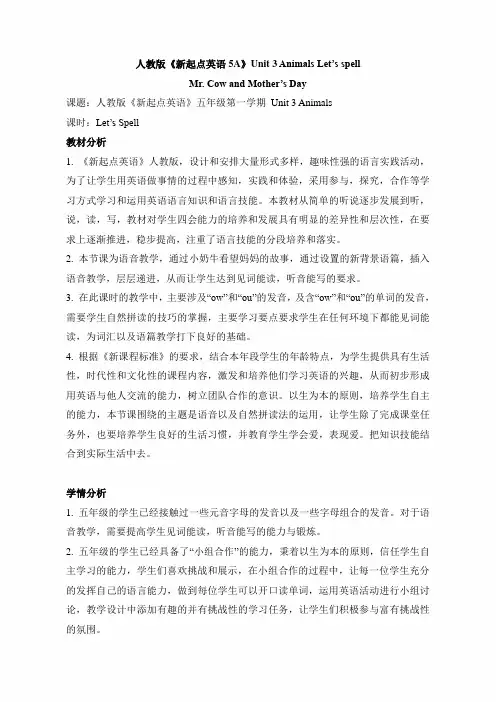
人教版《新起点英语5A》Unit 3 Animals Let’s spellMr. Cow and Mother’s Day课题:人教版《新起点英语》五年级第一学期Unit 3 Animals课时:Let’s Spell教材分析1. 《新起点英语》人教版,设计和安排大量形式多样,趣味性强的语言实践活动,为了让学生用英语做事情的过程中感知,实践和体验,采用参与,探究,合作等学习方式学习和运用英语语言知识和语言技能。
本教材从简单的听说逐步发展到听,说,读,写,教材对学生四会能力的培养和发展具有明显的差异性和层次性,在要求上逐渐推进,稳步提高,注重了语言技能的分段培养和落实。
2. 本节课为语音教学,通过小奶牛看望妈妈的故事,通过设置的新背景语篇,插入语音教学,层层递进,从而让学生达到见词能读,听音能写的要求。
3. 在此课时的教学中,主要涉及“ow”和“ou”的发音,及含“ow”和“ou”的单词的发音,需要学生自然拼读的技巧的掌握,主要学习要点要求学生在任何环境下都能见词能读,为词汇以及语篇教学打下良好的基础。
4. 根据《新课程标准》的要求,结合本年段学生的年龄特点,为学生提供具有生活性,时代性和文化性的课程内容,激发和培养他们学习英语的兴趣,从而初步形成用英语与他人交流的能力,树立团队合作的意识。
以生为本的原则,培养学生自主的能力,本节课围绕的主题是语音以及自然拼读法的运用,让学生除了完成课堂任务外,也要培养学生良好的生活习惯,并教育学生学会爱,表现爱。
把知识技能结合到实际生活中去。
学情分析1. 五年级的学生已经接触过一些元音字母的发音以及一些字母组合的发音。
对于语音教学,需要提高学生见词能读,听音能写的能力与锻炼。
2. 五年级的学生已经具备了“小组合作”的能力,秉着以生为本的原则,信任学生自主学习的能力,学生们喜欢挑战和展示,在小组合作的过程中,让每一位学生充分的发挥自己的语言能力,做到每位学生可以开口读单词,运用英语活动进行小组讨论,教学设计中添加有趣的并有挑战性的学习任务,让学生们积极参与富有挑战性的氛围。
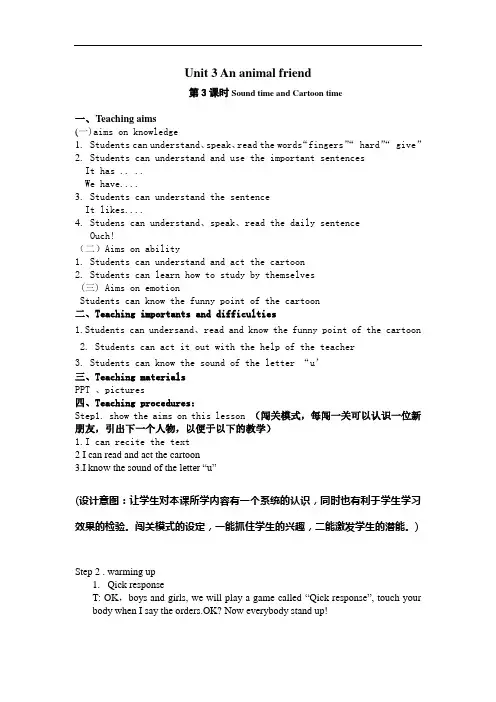
Unit 3 An animal friend第3课时Sound time and Cartoon time一、T eaching aims(一)aims on knowledge1.Students can understand、speak、read the words“fingers”“ hard”“ give”2.Students can understand and use the important sentencesIt has .. ..We have....3.Students can understand the sentenceIt likes....4.Studens can understand、speak、read the daily sentenceOuch!(二)Aims on ability1. Students can understand and act the cartoon2. Students can learn how to study by themselves(三) Aims on emotionStudents can know the funny point of the cartoon二、Teaching importants and difficulties1.Students can undersand、read and know the funny point of the cartoon2. Students can act it out with the help of the teacher3. Students can know the sound of the letter “u’三、Teaching materialsPPT 、pictures四、Teaching procedures:Step1. show the aims on this lesson (闯关模式,每闯一关可以认识一位新朋友,引出下一个人物,以便于以下的教学)1.I can recite the text2 I can read and act the cartoon3.I know the sound of the letter “u”(设计意图:让学生对本课所学内容有一个系统的认识,同时也有利于学生学习效果的检验。

小学五年级英语5AUnit3教案五年级英语教案教学内容简析:本单元的会话主要是通过mr. green上的一堂音乐课引出“谈论能力”为话题,学习can you …?yes, we can. /no, we can’t. i can… what can you do? 等句子。
在会话教学中,教师要尽可能的运用直观教具,如图片、体态语等,为学生创设直观情境,以帮助学生正确理解本单元所出现的句子的功能和意义,并引导学生进行操练、练习、运用,使学生能够在日常交际活动中熟练运用这些句子。
本单元出现的日常交际用语有listen to the song, please. now, follow me, please. yes. /ok. /all right.等,教师在教学中可以边演示、边说这些句子,使学生在正确理解及听的懂的基础上能够进行口头表达和熟练运用。
本单元所出现的动词词汇,在3b教材中都已出现过,只有make是第一次出现。
在教学中,教师可采用全身反应活动法,让学生听听、做做,说说、演演,以活跃课堂气氛,强化学生的记忆,采用以旧引新、温故而知新的教学手段,达到由浅入深、逐步扩展的目的。
e部分look and read版块是个幽默小对话,教师在指导学生看图时,要提醒学生故事中两个男孩动作的危险性,平时不要模仿。
对话中出现的新单词只要求学生能够听懂、会说、会读,并能在日常交际中初步运用。
教学要求:1 1能听懂、会说、会读和会拼写单词a lesson, a song, can, sing, dance, play, lesson, listen, swim, make, ride, put, can。
2 2能听懂、会说、会读和会写句型can you …? yes, i /we can. /no, i /we can’t. i can … what can you do?3 3能听懂、会说和会读日常交际用语和句型listen to …, please. now, follow me, please. yes. /ok. /all right. ok. let’s start. let’s sing it together.4 4初步掌握情态动词can的基本用法。
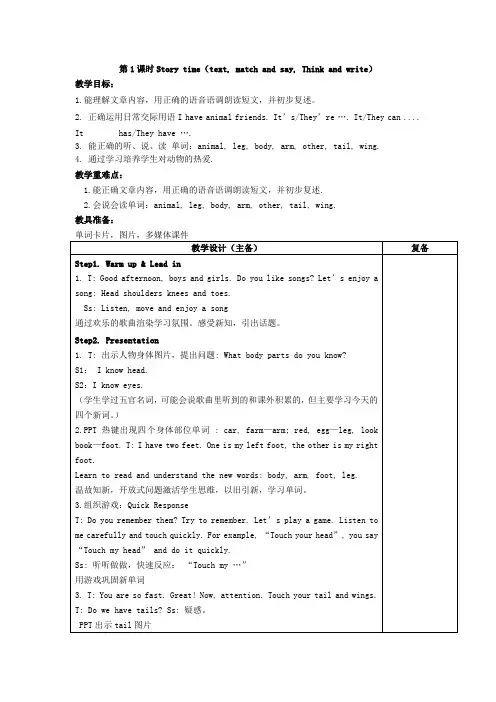
第1课时Story time(text, match and say, Think and write)教学目标:1.能理解文章内容,用正确的语音语调朗读短文,并初步复述。
2. 正确运用日常交际用语I have animal friends. It’s/They’re …. It/They can .... It has/They have ….3. 能正确的听、说、读单词:animal, leg, body, arm, other, tail, wing.4. 通过学习培养学生对动物的热爱.教学重难点:1.能正确文章内容,用正确的语音语调朗读短文,并初步复述.2.会说会读单词:animal, leg, body, arm, other, tail, wing.教具准备:第2课时Story time (words, Think and say)教学目标:1、能听懂、会读、会说并理解单词:have-has, doesn’t=does not,2、能够听懂、会说、会读句型:Do …have …? Yes, …do./No, …don’t. Does he/she have …? Yes, he/she does./No, he/she doesn’t.教学重难点:1、能够听懂、会说、会读句型:Do …have …? Yes, …do./No, …don’t. Does he/she have …? Yes, he/she does./No, he/she doesn’t.2、能简单的用第三人称描述动物。
教具准备:tape recorder第3课时Sound time and Cartoon time教学目标:1、能够听懂、会说、会读卡通故事中出现的词汇::fingers, hard, give,2. 能够流利地表达It has .. .. We have....的意思;3. 能够理解并掌握It likes....用法;4 能够听懂、会说、会读日常用语:Ouch!5. 能够整体理解并简单表演卡通对话教学重难点:1.学生能正确理解、朗读Cartoon time中的故事,能读懂其中的趣味之处,能在教师的指导下表演故事;2. .了解字母U在单词中的发音。
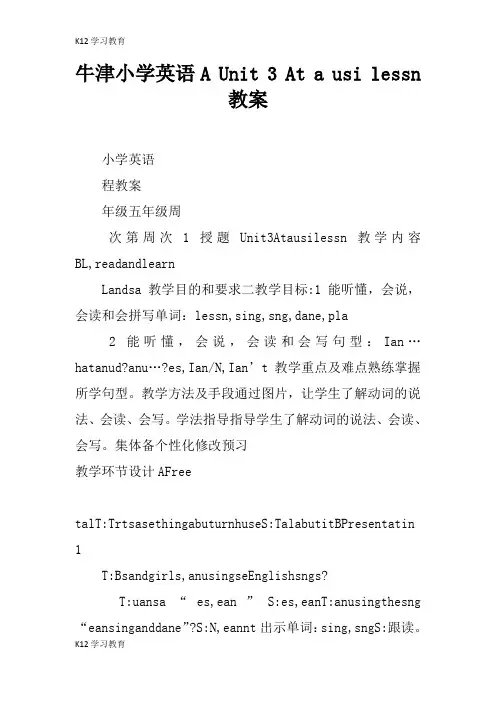
牛津小学英语A Unit 3 At a usi lessn教案小学英语程教案年级五年级周次第周次1授题Unit3Atausilessn教学内容BL,readandlearnLandsa教学目的和要求二教学目标:1能听懂,会说,会读和会拼写单词:lessn,sing,sng,dane,pla2能听懂,会说,会读和会写句型:Ian…hatanud?anu…?es,Ian/N,Ian’t教学重点及难点熟练掌握所学句型。
教学方法及手段通过图片,让学生了解动词的说法、会读、会写。
学法指导指导学生了解动词的说法、会读、会写。
集体备个性化修改预习教学环节设计AFreetalT:TrtsasethingabuturnhuseS:TalabutitBPresentatin 1T:Bsandgirls,anusingseEnglishsngs?T:uansa“es,ean”S:es,eanT:anusingthesng “eansinganddane”?S:N,eannt出示单词:sing,sngS:跟读。
Learnthenerds2T:hatanusing?S:“ABsng”,“Inthelassr”…3T:Iansing“TenlittleIndians”,hatanusing?S:Iansing“Hareu?”T:GdLet’ssing“Hareu?”firstS:Allright/2T:Bsandgirls,anusing?S:es,eanT:anudane?S:es,eanT:anusi?T:anusi?S:es,ean出示句型:anu…?3T:anusi?S:es,Ian/N,Ian’tT:anusate?S:es,Ian/N,Ian’tT:Ianplathevilinhatanud?S:IanplathepianIanplatheguitar出示单词:si,si,sate,plathevilin,platheguitarS:Learnthenerdsandsathesentenes出示句型:hatanud?Ian…hatanud?Pratie1ShthepiturefPart1Thestudentslatthepi turefPart,asandanserinpairs:2Latthepituresfpartandt rtaesesentenes作业1ptherds:lessn,sing,sng,dane,pla2Dserittenr板书设计Unit3AtausilessnIan…hatanud?Ian…anu…?es,Ian/N,Ian’t执行情况与教学反思小学英语程教案年级五年级主备人张海燕备时间XX年9月28日周次第6周次2授题Unit3Atausilessn教学内容AReadandsa教学目的和要求1、能听懂,会说,会读和会拼写单词:learn,listent,ae,ride,put,an2比较熟练的掌握句型:anu…?es,Ian/N,Ian’t3能听懂,会说,会读日常交际用语:Listent…,pleaseN,flle,pleasees//AllrightLet’ssingittgether教学重点及难点能够灵活运用所学日常交际用语。
Unit 3 At a music lesson一、教学要求:1、能听懂、会说、会读和会拼写单词a lesson , a song, can, sing, dance, play, lesson, listen swim, make, ride, out, can2、能听懂、会说、会读和会拼写句型can you...?Yes,I/we can. No,I/we can’t. I can... What can you do ?3、能听懂、会说和会读日常交际用语和句型Listen to ...please. N ow, follow me ,please. Yes/OK?All right. ’s start. Let’s sing ittogether.4、初步掌握情态动词can的基本用法。
5、了解元音字母a在单词中的读音。
6、能有表情的演唱歌曲We can sing and dance.二、教学重点:1、能听懂、会说、会读和会拼写单词a lesson , a song, can, sing, dance, play, lesson, listen swim, make, ride, out, can2、能听懂、会说、会读和会拼写句型can you...?Yes,I/we can. No,I/we can’t. I can... What can you do ?三、教学难点:能听懂、会说、会读和会拼写句型can you...?Yes,I/we can. No,I/we can’t. I can... What can you do ?四、教学过程:第一课时一、教学要求:1、看图学习单词能听懂、会说、会读和会拼写单词a lesson , can, sing, dance, play, lesson, swim, make,can12、能听懂、会说、会读和会拼写句型can you...?Yes,I/we can. No,I/we can’t. I can... What can you do ? 初步掌握情态动词can的基本用法。